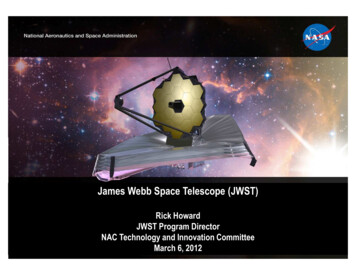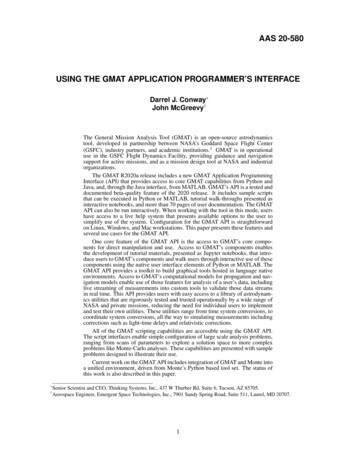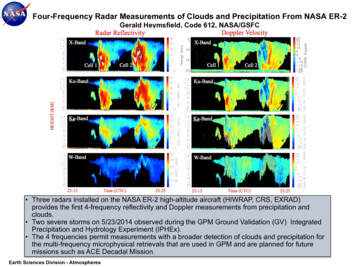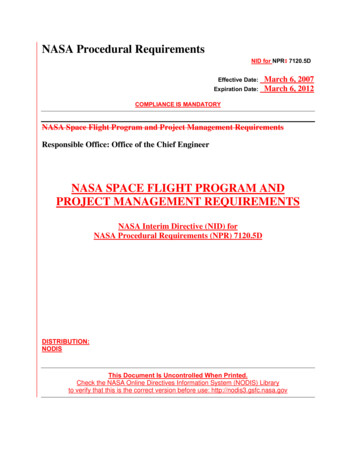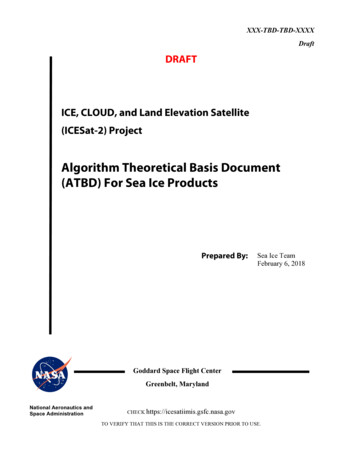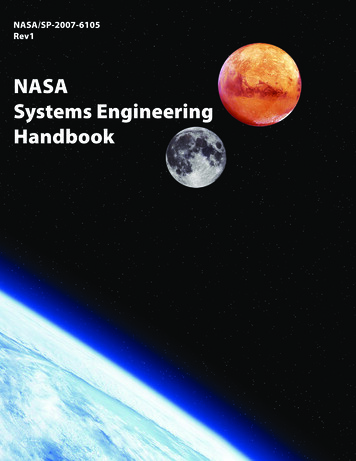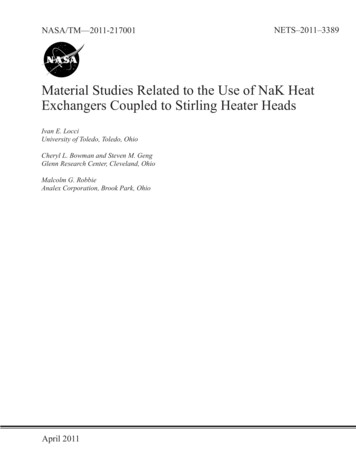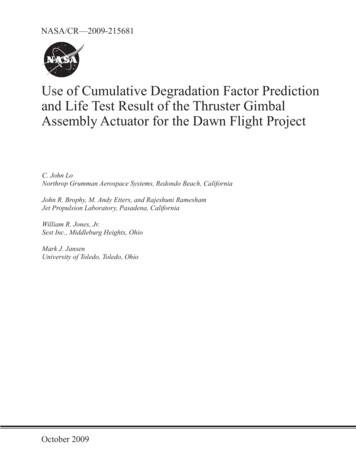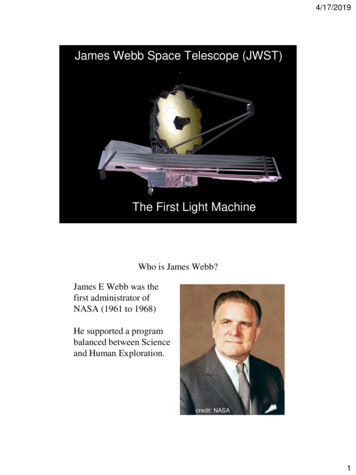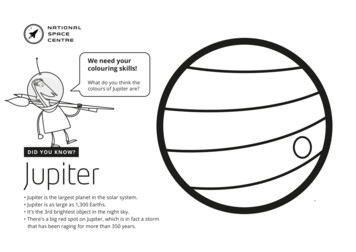
Transcription
We need yourcolouring skills!What do you think thecolours of Jupiter are?D I D Y OU K NO W?Jupiter Jupiter is the largest planet in the solar system. Jupiter is as large as 1,300 Earths. It's the 3rd brightest object in the night sky. There's a big red spot on Jupiter, which is in fact a stormthat has been raging for more than 350 years.
D I D Y OU K NO W?Saturn Saturn is the 2nd largest planet in the Solar System. 764 Earths could fit inside Saturn. Saturn's rings are made of ice and rock. They span 175,000 milesand yet they’re only 20 metres thick. Saturn is less dense than water. If there was a bathtub bigenough, Saturn would float on top of the water! The spacecraft 'Cassini' orbited around Saturn for 13 years, takinglots of photos and gathering important information.We need yourcolouring skills!What colours willyou choose?
D I D Y OU K NO W ?Space ShuttleThe NASA Space Shuttle flew a total of 135 missions from 1981 to 2011,launching numerous satellites, probes, the Hubble Space Telescope,conducting science experiments and participated in the construction of theInternational Space Station. When in orbit, the Space Shuttle travelled at a speed of around 17,500miles an hour and would see a sunrise or sunset every 45 minutes. The total mileage of all the Space Shuttles is 513.7 million miles andactually take us beyond Jupiter. The Space Shuttles are protected by 30,000 tiles that are constructedessentially of sand. The tiles can reach temperatures of up to 1,260Cand then be touch cool within a matter of minutes.We need yourcolouring skills!What colours willyou choose?
D I D Y OU K NO W?SpaceX Dragon 2May 27 2020 is the target launch date for the first crewed spacemission to launch into orbit from U.S. soil since the retirement of thespace shuttle in 2011.Falcon – the rocket / Dragon – the capsule In 2010, SpaceX became the first company to launch a privatelybuilt spacecraft into orbit and return it safely to Earth. Dragon is named after "Puff the Magic Dragon", due to manypeople thinking the idea impossible, much like a magic dragon. The first Dragon to be launched carried a wheel of cheese intoorbit. Apparently, this was in honour of a very famous sketch fromMonty Python's Flying Circus. The Falcon rockets are named after the Millennium Falcon fromStar Wars.We need your colouring skills!What colours will you choose?
We need yourcolouring skills!D I D Y OU K NO W?SpaceX Falcon 9May 27 2020 is the target launch date for the first crewed spacemission to launch into orbit from U.S. soil since the retirement of thespace shuttle in 2011.Falcon – the rocket / Dragon – the capsule In 2010, SpaceX became the first company to launch a privatelybuilt spacecraft into orbit and return it safely to Earth. Dragon is named after "Puff the Magic Dragon", due to manypeople thinking the idea impossible, much like a magic dragon. The first Dragon to be launched carried a wheel of cheese intoorbit. Apparently, this was in honour of a very famous sketch fromMonty Python's Flying Circus. The Falcon rockets are named after the Millennium Falcon fromStar Wars.What colours willyou choose?
D I D Y OU K NO W ?Lovell TelescopeSited at the Jodrell Bank Observatory in Cheshire, this 76.2m acrosstelescope was once the largest of its kind. As well as helping to unlock thesecrets of our Universe it was used to track space probes including missionsto the Moon and Mars!We need yourcolouring skills!What colours willyou choose?
We need yourcolouring skills!Help us colour in theHubble Space Telescope.D I D Y OU K NO W ?Hubble SpaceTelescopeAfter 30 years, this space telescope is still providing us with stunningimages and information about our Universe. It has provided most ofthe well-known images of our Universe, from galaxies and nebula tothe death of stars.
D I D Y OU K NO W ?Cosmic BackgroundExplorer (COBE)Launched in 1989, this telescope studied the Cosmic MicrowaveBackground Radiation of our Universe – and provided great evidence tosupport the Big Bang theory of our Universe.We need yourcolouring skills!What colours willyou choose?
D I D Y OU K NO W ?James WebbSpace TelescopeDue to launch in 2021, this enormous telescope is the size of atennis court. In fact, it is so big it will have to launch folded up!We need your colouring skills!What colours will you choose?
D I D Y OU K NO W ?HisakiThis Japanese satellite was the first ever satellite designedspecifically to observe the atmospheres planets in oursolar system – particularly Venus, Mars and Jupiter.We need yourcolouring skills!What colours willyou choose?
D I D Y OU K NO W ?XMM NewtonThis European space telescope is investigating distantinterstellar X-ray sources. It was the first telescope to allowscientists to measure the spin rate of a black hole!We need yourcolouring skills!What colours willyou choose?
D I D Y OU K NO W?Neil Gehrels SwiftObservatoryThis NASA space observatory is hunting for gamma ray bursts –high energy explosions believed to be produced by supernovae!We need yourcolouring skills!What colours willyou choose?
D I D Y OU K NO W ?VeneraBetween 1961 and 1984 the Venera program sent a series ofspace probes to gather information about the planet Venus.Venera means Venus in Russian.We need yourcolouring skills!On 01 March 1966 Venera 3 became the first spacecraft to reachthe surface of another planet.What colours willyou choose?
D I D Y OU K NO W ?Venera 9Venera 9 consisted of an orbiter and a lander.It was launched on 08 June 1975.The orbiter was the first spacecraft to orbit Venus.During its 53 minutes of transmissions from the surface, Venera 9took the very first picture of the Venusian surface.We need yourcolouring skills!What colours willyou choose?
D I D Y OU K NO W ?OrbitingSolar ObservatoryThe Orbiting Solar Observatory (OSO) program successfully launched 8 spacetelescopes between 1962 and 1975, primarily intended to study the Sun, though theyalso included important non-solar experiments.In 1964 OSO-4 included X-ray equipment from the University of Leicester. This launchbegan an unbroken period of 30 years' duration, with Leicester-built X-ray instrumentsoperating in orbit.In 1969 NASA launched OSO-5. Again, the X-ray telescope on board was from theUniversity of Leicester and for the next six years provided daily images of solar activity.You can see OSO at the National Space Centre.We need your colouring skills!What colours will you choose?
D I D Y OU K NO W ?Solar andHeliospheric ObservatoryThe Solar and Heliospheric Observatory (SOHO)was launched in 1995, to study the Sun.It is a joint project between the European Space Agency (ESA) and NASA.As well as observing the sun, it has discovered over 3,000 comets.Originally planned as a two-year mission, SOHO continues to operate after over 25 years in space.You can see SOHO at the National Space Centre.We need yourcolouring skills!What colours willyou choose?
We need yourcolouring skills!What colours willyou choose?D I D Y OU K NO W?International Space StationIn 24 hours, the space station makes 16 orbits of Earth, travelingthrough 16 sunrises and sunsets.The living and working space in the station is larger than asix-bedroom house (and has six sleeping quarters, two bathrooms,a gym, and a 360-degree view bay window).The space station has been continuously occupied since November 2000.Made up of hundreds of major and minor components, the ISS is thelargest crewed object ever put into space.The space station travels an equivalent distance to the Moon and back inabout a day.
D I D Y OU K NO W ?SkylabSkylab was launched on May 14, 1973, from NASA's Kennedy Space Center bya Saturn V launch vehicle.Skylab was the first space station operated by the United States. It spent sixyears orbiting Earth.Three crews occupied the workshop for a total of 171 daysAstronauts aboard the station conducted 270 experiments in biomedical andlife sciences, solar astronomy, Earth observations and materials processing.We need your colouring skills!What colours will you choose?
six-bedroom house (and has six sleeping quarters, two bathrooms, a gym, and a 360-degree view bay window). The space station has been continuously occupied since November 2000. Mad

